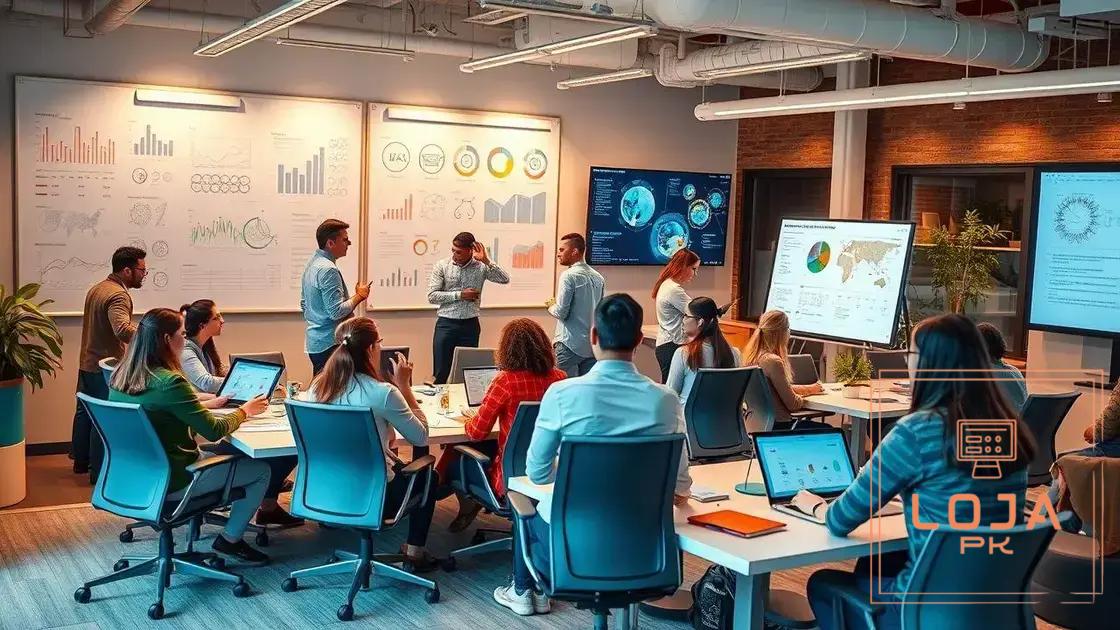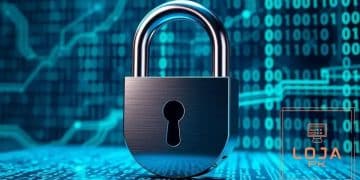Strategies to secure systems from disinformation in 2025

Strategies to secure systems from disinformation in 2025 include fostering critical thinking, leveraging innovative technologies, and promoting collaborative efforts among diverse organizations to effectively combat misinformation.
Strategies to secure systems from disinformation in 2025 are becoming increasingly crucial as the digital landscape evolves. With new tactics emerging, how can organizations stay one step ahead? Let’s dive into effective methods to enhance resilience.
Understanding disinformation threats
Understanding disinformation threats is crucial in today’s digital world. As technology evolves, so do the methods used to spread false information. Organizations need to be aware of these threats to effectively protect themselves.
Types of Disinformation
Disinformation can take many forms. Recognizing each type helps in crafting effective responses. The most common types include:
- Fake news: News articles that are entirely fabricated.
- Manipulated content: Genuine information altered to mislead.
- Imposter content: When genuine sources are mimicked to create false narratives.
These forms of disinformation can cause confusion and harm to both organizations and individuals. As such, knowing how to identify them is essential.
Impact of Disinformation
The impact of disinformation is significant. It can erode trust in institutions, lead to poor decision-making, and disrupt social cohesion. For instance, during elections, disinformation can influence voter behavior and undermine democratic processes.
Moreover, businesses that fall victim to disinformation may suffer reputational damage, financial losses, and a decrease in customer trust. It is vital to understand the ramifications to mitigate these risks effectively.
By staying informed about the various disinformation threats and their impacts, organizations can develop better strategies to counteract their effects.
Evaluating current security measures

Evaluating current security measures is a critical step in defending against disinformation. Organizations must proactively assess how well their systems protect information and prevent the spread of false narratives. Regular evaluations ensure that security measures evolve alongside emerging threats.
Key Areas of Evaluation
When evaluating security measures, it is essential to focus on several key areas:
- Policy effectiveness: Are current policies effective in addressing disinformation?
- Training programs: Do staff receive adequate training to recognize and respond to disinformation?
- Technology usage: Is the technology in use up to date and capable of countering the latest threats?
By assessing these areas, organizations can identify weaknesses and opportunities for improvement. This enables them to implement stronger defenses.
Metrics for Success
Metrics play a vital role in determining the effectiveness of security measures. Tracking specific indicators allows organizations to measure progress. Reliable metrics include:
- Incident reduction: Fewer incidents of disinformation reaching the public.
- Response time: Improved speed and efficiency in handling disinformation cases.
- Awareness levels: Increased understanding of disinformation among staff.
Using these metrics, organizations can develop data-driven strategies to enhance their security posture.
In summary, consistently evaluating security measures helps ensure that organizations remain resilient against disinformation threats. By focusing on key areas and using relevant metrics, they can build a robust defense mechanism that adapts to an ever-changing landscape.
Innovative technologies for countering disinformation
Innovative technologies for countering disinformation are essential in today’s information-driven world. As false information spreads rapidly, organizations must leverage cutting-edge tools and techniques to protect their integrity. New advancements can help identify and neutralize disinformation effectively.
Artificial Intelligence and Machine Learning
One of the most promising areas is artificial intelligence (AI) and machine learning (ML)</strong). These technologies analyze large volumes of data to detect patterns indicative of disinformation. AI can automate the identification of fake news and flag it for review.
- Natural Language Processing: This helps understand and evaluate content quality by analyzing language.
- Sentiment Analysis: AI can gauge public reactions to information, helping organizations respond appropriately.
- Predictive Analytics: Anticipating potential disinformation threats before they escalate.
These technologies significantly enhance an organization’s ability to respond swiftly and effectively to emerging threats.
Blockchain for Verification
Another innovative technology is blockchain. This decentralized ledger system offers a transparent method for verifying information sources. By providing a secure way to track the origin of information, blockchain can help verify authenticity.
Moreover, it can be used to create digital identities, ensuring that information is attributed to credible sources. This transparency builds trust among users and improves the reliability of shared information.
Collaborative Platforms
Collaborative platforms for sharing information and insights can play a significant role in combating disinformation. These platforms allow stakeholders to share real-time data about threats, enabling a collective response. For instance:
- Community Reporting: Allow users to report suspicious content.
- Knowledge Sharing: Organizations can share resources and best practices.
- Rapid Response Teams: Engage experts to address disinformation quickly.
Utilizing these innovative solutions, organizations can develop a multifaceted strategy to tackle disinformation effectively.
Building a culture of critical thinking

Building a culture of critical thinking is essential in today’s world, especially to guard against disinformation. A robust culture encourages individuals to question information and sources actively. It empowers them to analyze content rather than accept it at face value.
Importance of Critical Thinking
Critical thinking helps people distinguish between fact and opinion. In an era where misinformation spreads quickly, this skill is vital. By fostering critical thinking skills, organizations enable individuals to protect themselves from misleading information.
- Enhanced Decision-Making: Individuals who think critically make better decisions.
- Informed Opinions: Critical thinkers are more likely to form opinions based on facts.
- Stronger Communication: Clearer reasoning aids dialogue and debate.
When everyone practices critical thinking, the entire organization benefits.
Training and Workshops
To promote critical thinking, organizations can implement training and workshops. These initiatives can help employees develop the necessary skills to analyze and evaluate information. Topics might include:
- Identifying Bias: Learning to spot biases in news and data.
- Evaluating Sources: Checking the reliability of various information sources.
- Argument Analysis: Understanding logical fallacies and building sound arguments.
These training sessions encourage a mindset that questions information and approaches it with skepticism.
Encouraging Open Discussions
Creating a safe environment for open discussions also fosters critical thinking. Encouraging employees to share their thoughts without fear promotes diverse perspectives. This exchange of ideas can lead to better solutions and a deeper understanding of complex issues.
By integrating critical thinking into everyday practices, organizations can cultivate an atmosphere where employees actively engage in thought, analysis, and constructive criticism. Such a culture is vital for combating disinformation and fostering informed decision-making.
Collaborative efforts to combat disinformation
Collaborative efforts to combat disinformation are crucial in today’s interconnected world. By joining forces, organizations, communities, and individuals can tackle misinformation more effectively. This teamwork enhances the ability to share resources, knowledge, and strategies to address the spread of false information.
The Power of Partnerships
Establishing partnerships with various stakeholders amplifies the reach and impact of anti-disinformation initiatives. Different groups bring unique perspectives and expertise. Potential partners include:
- Government agencies: Providing regulatory frameworks and support.
- Tech companies: Developing tools to spot and block disinformation.
- Academic institutions: Researching the effects of disinformation and best practices.
These collaborations can foster innovative solutions and establish best practices.
Community Engagement
Engaging communities is another essential aspect of countering disinformation. Involving the public enables a more grassroots approach. Communities can host workshops, share resources, and create local campaigns that educate people about recognizing and responding to disinformation. By working together, community members can build resilience against misinformation.
This collective effort encourages dialogue and fosters a culture of critical thinking, empowering individuals to challenge false information actively.
Information Sharing Networks
Creating information-sharing networks can greatly improve the fight against disinformation. These networks facilitate real-time communication and resource sharing. Organizations can share data, trends, and best practices, helping others stay informed about emerging threats. This collaboration can be beneficial:
- Timely Alerts: Quick notifications of disinformation trends.
- Resource Libraries: Access to tools and guides for combating disinformation.
- Collective Research: Collaborating on studies for better understanding.
By forming robust collaborations, communities and organizations can effectively address the challenges posed by disinformation. Working together strengthens the overall response and enhances resilience against this pervasive issue.
In conclusion, addressing disinformation requires a comprehensive approach that combines innovative technologies and collaborative efforts. By fostering a culture of critical thinking, organizations can empower individuals to recognize and challenge false information. It’s essential to engage communities, share resources, and form partnerships that enhance resilience against this pervasive issue. Together, we can build a more informed society that values truth and transparency.
FAQ – Frequently Asked Questions about Combatting Disinformation
What role does critical thinking play in combating disinformation?
Critical thinking helps individuals analyze and question information, enabling them to identify false narratives more effectively.
How can collaboration enhance efforts to fight disinformation?
Collaboration allows diverse stakeholders to share resources and knowledge, improving overall strategies to counter misinformation.
What types of technologies are useful in detecting disinformation?
Technologies like artificial intelligence and machine learning can analyze data patterns to spot and flag potential false information.
How can communities get involved in addressing disinformation?
Communities can organize workshops, create local campaigns, and share information to educate others about recognizing and responding to disinformation.





